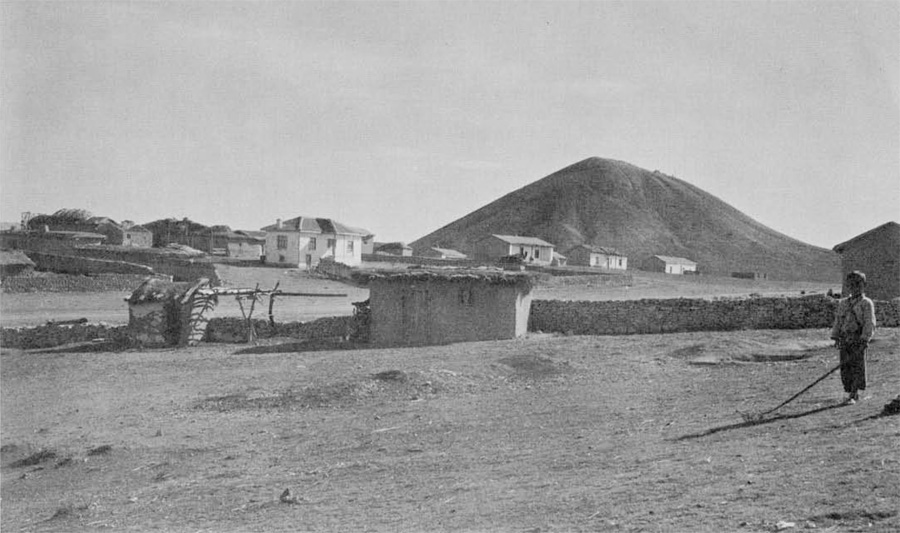
The Museum expedition first went to work at Gordion in 1950. Always before the eyes of its members stood the biggest of the grave mounds, some 165 feet in height and covering an area of more than 55,000 square yards, a dominant feature of the local landscape not easily overlooked. This huge artificially-heaped mound served at the same time as monument and protection over the tomb of a single person–evidently, from the size of the mound, a very important person.
It had drawn archaeologists to Gordion before 1950, some of them with a predatory gleam in their eye. A German expedition spent three months in the summer of 1900 digging at Gordion; they had been drawn there in part at least by the thought of digging the great tumulus. They dug five of the smaller mounds, and made trenches on the city site; but in the end they decided that the biggest tumulus was beyond their means financially and technically.

Our own Museum expedition was not uninfluenced by the possibility of exploring this mound when it chose Gordion as the site for a long-term excavation. The digging of the city site has been most satisfactory, illustrating episodes in the history of the town, giving us some idea of the civil and military architecture of ancient Phrygia, showing the methods of construction and hinting at the skills of the architects and engineers, the mosaicists and the sculptors, and supplying us liberally with the household wares and artifacts used in the town.
The Phrygian Kingdom fell before an invasion of Cimmerian barbarians early in the seventh century B.C.; Gordion was burned and never flourished again as the capital of a powerful and independent state. The site evidently lay abandoned until the town was rebuilt in the time of the Persian Empire, probably as an administrative center and garrison town. But the small area of the city destroyed by the Cimmerians that has been uncovered thus far has already shown that the Phrygians had reached a far higher level of culture before the catastrophe than could ever have been anticipated from what was already known of them; and more is to come.
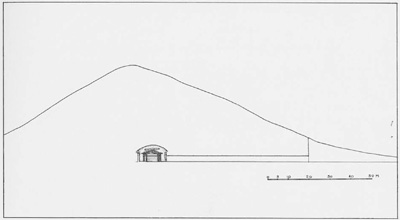
Image Number: 68107
Doubtless the Cimmerians looted the town before they burned it, carrying off everything of value to them. But the values of a predatory nomad were (we hope) different to those of a modern archaeologist or historian; a few inscribed clay tablets, which he would have considered of no worth, or some sculptured slabs which he would have found too heavy to carry off (even if he had wanted them), will give us more solid historical information than would many a portable object made of material more value than clay or limestone. Let him have them.
Nevertheless, the tombs at Gordion (as at any site) offer promise of a different sort: if intact and unlooted they offer objects which are complete and unbroken, instead of mere fragments; they offer the possibility of the preservation of objects made of perishable materials which would never have survived in a more exposed environment; and above all, they offer groups of objects all placed in the tomb at the same time–a closed deposit in which everything may be taken to be more or less contemporary. If the tomb is that of a king we may naturally expect objects of greater value, intrinsic, artistic, or historical. The archaeologist is able, and often is compelled, to illustrate his results with, as it were, a rag, a bone, and a hank of hair; but if the tombs are available and can be reached they are likely to contain objects much more impressively illustrative of the culture of the times, and at the same time groups of objects which may serve as checks against the results obtained by stratified digging in the settlements.
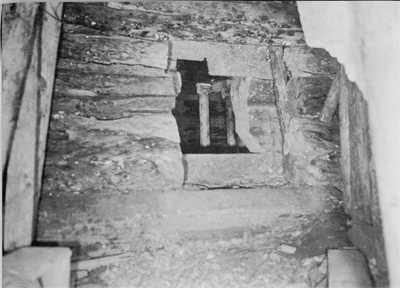
These thoughts were not absent from the heads of the excavators during the years from 1950 to 1957, when the exploration of the greatest mound was finally undertaken. A good deal of exploratory work was done, and much information was gathered. In 1950 and 1951 fourteen of the smaller grave mounds were dug, and the somewhat discouraging conclusion was forthcoming that the tomb is seldom to be found under the center of a mound. It became evident that some means must be devised for locating the position of the tomb under the greatest tumulus before an attempt could be made to reach it. Only the boldest of men would have dug down at the center of this mound, or tunneled in directly toward the center, on faith and without any previous knowledge of where the tomb was to be sought. And in the case of the Gordion tumulus the matter was complicated by the consideration that this is the biggest tumulus in Asia Minor, a monument in itself and therefore not to be wantonly destroyed or mutilated.
The problem was considered from various angles until finally a promising solution was offered by good friends with experience in drilling for oil. A light drilling rig was procured with which it was possible by a succession of borings to locate and map the area beneath the mound occupied by the pile of loose stones which experience had taught us to expect overlying the tomb chamber. At the same time there was no danger that the drill would go through the stone-pile to do damage within the tomb itself. The fall of 1955 and the summer of 1956 were occupied by the drilling; the stone-pile, about 100 feet in diameter, was located just to the southwest of the center of the mound. A by-product was the excavation, in the spring of 1956, of an important child’s tomb which had been located in a practice session of drilling under a smaller tumulus (P).
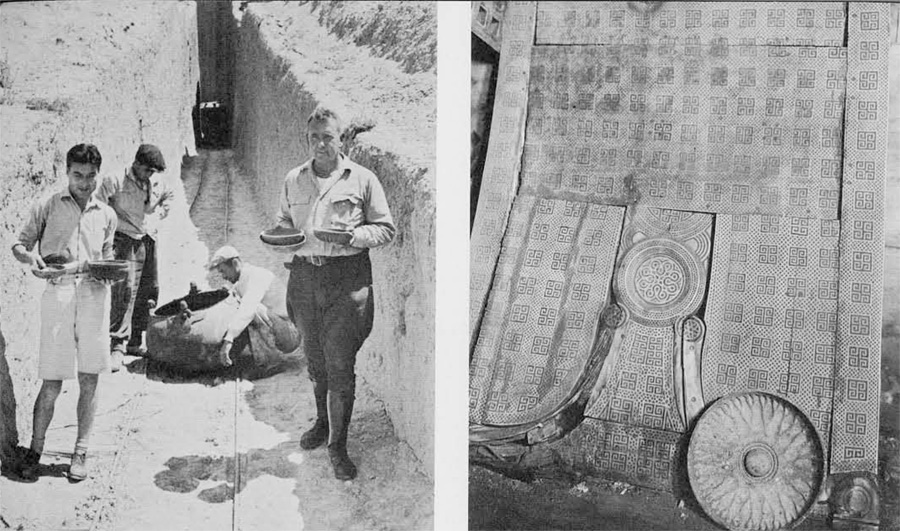
Photograph by James Whitmore, courtesy LIFE Magazine
(right) Inlaid wooden screen. The color contrast is of dark yew inlaid into boxwood.
Image Numbers: 140758, 64389
The general area of the tomb having been located with reasonable certainty, we were faced by the problem of how to reach it. A rough calculation showed that a trench from the top would have to be at a maximum 130 feet deep, and correspondingly wide and long; it would ruin the tumulus, and involve the moving of about 80,000 cubic yards of earth. As this prospect was too discouraging to be faced it was decided to make a tunnel aimed at the center of the stone-pile as it had been located by the drilling. An open trench was cut on the line indicated, from the edge of the mound to a point from which tunneling was to start, a distance of about 220 feet. The outer half of this trench was entirely through filling washed down from the tumulus itself in the long course of time; the outer edge of the original mound was clearly visible in the scarp, and the ancient tumulus must have been considerably less in diameter, but notable higher, than the present one. The tunnel was made by miners imported from the Zonguldak mining district of Turkey, who brought their own foreman and a carpenter used to the installation of pit-props. As the tumulus was here entirely of hard clay a minimum of these was necessary.
The miners set a noble example by working around the clock in three shifts, which astonished our local workmen; in twenty-five days they carried the tunnel in to a distance of about 230 feet, where they were stopped by a built wall of stone right across the line of tunneling. It may be noted that in the entire length of trench and tunnel, about 450 feet, not more than ten nondescript potsherds were found the clay filling of the mound was very clean.
The stone wall across the line of our tunnel indicated that we were near the tomb, though there was no way of knowing whether or not it was the wall of the tomb itself, in this case built of stone instead of wood. According to out computations we were well within the area of the stone-pile, and a hole made through the roof of the tunnel, letting in a shower of small stones from above, confirmed our calculations: the hole was quickly sealed off. A pit against the face of the wall showed it to go at least two courses below the top of the hardpan, and so the only possible procedure seemed to be to break a hole through the wall. This being done, a mass of small stones began to rush out– a discouraging sight, implying that the roof of the tomb was broken. Our main concern at first had been whether the tunnel would find the tomb, or come empty-handed out the other side of the mound. This concern was relieved by the finding of the stone wall; the next burning question was whether the tomb would be intact or whether the roof had broken, allowing an inrush of stone from above to smash and disperse the contents.
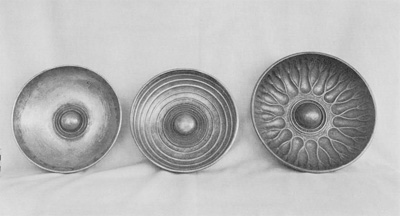
When enough stone had flowed out through our opening to allow a sight of the inner face of the stone wall we were relieved to see that it was rough– evidently not a finished face such as might be expected on the walls of a royal tomb. For a whole week the rubble continued to pour down and to be carted away. At the end of this time the wall of an inner tomb structure of wooden logs had begun to appear, about six feet within the stone enclosure wall. Finally we were able to bring our tunnel in to the face of this wall. The roof of the area over the stone-pile was now visible: a domed vault of clay so hardened and compacted by pressure in the course of time that it stood of itself when the stone-pile, of which it was the mould, was withdrawn from underneath. By this time we were morally certain, from the amount of rubble we had taken out, that the roof must be intact– had it broken, a huge amount of stone would have rushed down into the tomb, leaving a void under the clay dome. Nevertheless, one more trial awaited our faith and patience: when we procured a long auger and bored through the log wall in three places, the tool in every case found more stone on the other side!
In view of these negative results there was nothing to do but cut a window through the wall big enough to show what lay within. As the auger had predicted, the window showed only more stone rubble. This time, however, we were not held long in suspense; after only about an hour enough rubble had been taken out to reveal the face of a second wooden wall, here made of nicely squared and fitted timbers rather than rough logs. The auger was at hand and bored through the wood without encountering stone at the other side; it was now certain that the tomb was intact and the roof unbroken! A small window was cut through the inner wall, big enough to insert only the head and one arm, with a flashlight. The staff took turns looking in; the tomb was large, the atmosphere dense, the flashlight weak. Among the wonders thus seen were a chariot, and a stuffed alligator!
The tomb had been intended for a single burial, and was made without a door or other means of access. We may probably assume that the stone enclosure wall and the inner wooden chamber up to roof level were made during the lifetime of the prospective occupant. The outer wooden wall must have been made at the same time, and all the space within the enclosure filled with rubble, for the long found logs of the outer wall, piled on top of the other, were in no way fastened together at the corners and were thus held in place only by the rubble filled in at either side. When the time came the burial was made and the grave offerings were put into the tomb from above; then the double-pitched wooden roof was put on, the great heap of stones piled over it, and the tumulus constructed over that to a height of more than 130 feet. A “raft” of long logs laid side by side in the rubble across the width of the tomb, and to its whole length, above the roof served to distribute the enormous pressure of the huge mass of stones and earth above. Its presence hints at the skill of the Phrygian engineers at the time, and to it is probably due the preservation of the tomb roof unbroken.
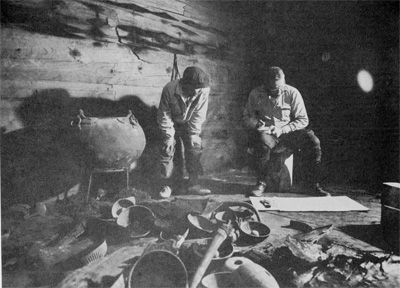
Photograph by James Whitmore, courtesy LIFE Magazine
The chamber measured about 17 by 20 feet inside, with a north-south orientation and with a height of about 10 feet to the top of the long walls. The roof, of long squared beams, was supported on shallow triangular gables at the ends and by a similar gable at the center, carried on huge cross-beams spanning the chamber. The wood, not yet identified by a specialist, seems to be pine. The joints between the timbers of the walls are in many cases all but invisible, so nicely are the beams fitted together. The inner wall-face seems to have been finished with the adze before sanding; flaws in the timbers were neatly cut out and the cavities were filled with closely fitted wooden plugs.
The dead man had been laid, head toward the east, on a great four-poster bed along the north wall of the room, its foot in the northwest corner. The bed had been spread with a coverlet of many thicknesses of cloth of various colors of wool and linen. The skeleton lay extended on its back with the legs stretched out and the arms along the sides. It had evidently been dressed in a skirt of leather with a zone of studded bronze decoration above the hem, and a sleeved shirt of cloth fastened at the shoulders, elbows, and wrists by bronze fibulae or safety-pins. Professor Muzaffer Senyurek of the Ankara University has identified the skeleton as that of a male, sixty to sixty-five years of age, and of rather slight stature– his height in life was only about 5’2″. All the evidence– the richness of the grave offerings, the scale of the tomb itself, and the gigantic size of the mound heaped over it– suggests that this must have been a royal personage; probably a king of Phrygia who reigned in the years of its greatest prosperity, and certainly one who died and was buried before the final catastrophe of the early seventh century.
If, then, the Greek tradition is correct that the famous King Midas was still on the throne at the time of the Cimmerian conquest, probability would indicate that the occupant of our tomb was his immediate predecessor, a king who reigned in the latter part of the eighth century. This dating is confirmed by some of the finds in the tomb itself, and by radiocarbon tests run on samples of the wood from its walls, which gave an age of 2700 years, or approximately 743 B.C.
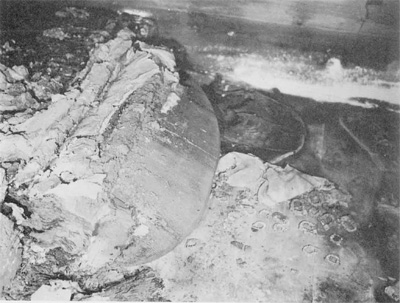
Image Number: 64362
The furniture of the tomb in addition to the great four-poster bed consists of two elaborately inlaid wooden screens, standing against the east wall of the chamber; a most complicated table beside them, carved and inlaid and put together from multifarious pieces; and eight three-legged tables of simpler form. Of the last, one had stood by the head of the bed, five near the center of the room, and two in the southeast corner. All of the wooden tables had collapsed in the long course of time, and were found lying on the floor in pieces; in their collapse they had dumped over the floor the bronze vessels originally placed upon them. Without exception the tables were made with three legs of hard, light-colored wood, probably boxwood, bent to a curve. The tops were of a soft brown wood, not well preserved– probably a species of soft pine. The wooden screens were of light wood inlaid with dark– probably boxwood with yew inlay. They had been put together before inlaying from a number of pieces cunningly fitted and fastened by tongues and sockets, the tongues held in place by pegs run through from the front. The separate pieces were so nicely fitted that in some cases the joints were quite invisible, their presence betrayed only by the heads of the pegs to either side.
The inlay was in various geometric designs, mostly elaborate variations of a swastika motif; but at the center of each screen there is a round medallion or “rose window” filled by a complicated curvilinear inlay design. Below the medallions at either side are curved inlaid pieces like the legs of the plain tables, extending to the lower corners where they end in scroll-like feet. The screens were supported at the back by single legs which prevented them from tipping over. They serve as guides in the restoration of the very similar piece found in fragments in the child’s tomb in 1956. We may suppose that they could have been used as screens, or as throne-backs to lean against while seated on a portable stool or cushion placed in front.
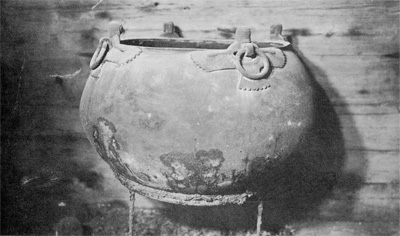
Museum Object Number: 58-36-1
The south end of the chamber was occupied by three large cauldrons of bronze set upon ring-bases of iron. Inside these had been placed pottery vessels containing food and drink for the dead; samples are now undergoing chemical analysis. All the pots were of plain black-polished ware without decoration, found in a sad state of decomposition probably as a result of chemical action by their contents. On the wall of one of these vases was scratched a brief alphabetical inscription, now incomplete.
The bronze cauldrons are themselves of great interest and value. One of them is adorned with two handle attachments in the form of bull heads, to which are fastened ring handles by which the vessel could be lifted. It is quite possible that this cauldron was a local product, made at Gordion. Another cauldron with bull-head attachments is known, and there are several of the bull attachments, now detached from the cauldrons they once adorned. Most of the come from the region of Lake Van and are considered the products of the local Urartian bronze-smiths; but they differ in many details of style from our Gordion cauldron, which is thus in all likelihood the product of an independent and contemporary center of bronze working. A second complete cauldron, resembling the Gordion one in details of style and probably a product of the same workshop was found at Cumae in Italy– an import from Anatolia– and is now in the museum at Copenhagen.

The second cauldron has four attachments in the form of sirens– hybrids with human heads, shoulders, and arms, and bird wings and tails. This vessel had evidently seen some use before it was placed in the tomb, for all of the handle-rings are missing, and two of the sirens have lost the ends of their tails. Close measurement has shown that each of the sirens was cast from a different mould; later study has brought out the personality of each figure, which differs from that of her sisters. Details of hair, sleeve- and neck-borders of dresses, and feathers of wings and tails are rendered by copious surface engraving. The siren attachments find parallels in various places, some as far distant as the Etruscan tombs in Italy; they were evidently much admired and widely imported. Imitations were soon made both in Greece and in Italy, but the local imitators made their own alterations of the types and usually a glance suffices to distinguish between the oriental importations and the local adaptations. It is not yet clear what was the original source of these siren cauldrons; they may have been Assyrian or Urartian, or possibly Phrygian.
The third cauldron combined with two normal siren attachments like those of the second, two square-bearded heads of Assyrian type which in style closely resemble small Assyrian figures of ivory of the late eighth century. Again, the source of this cauldron is not clear, though in its case Assyria seems probable. The floor of the tomb was covered with bronze vessels, fallen from the tables when they collapsed, or from iron nails driven in evenly spaced rows into the walls when these rusted through and gave way. The table at the head of the bed had supported a linen sack filled with bronze fibulae, 145 in all, doubtless the personal jewelry of the king. Ten of these were of a heavy double-pinned type adorned with handsome and ingenious safety-catches to prevent them from opening, and to shield the sharp points of the pins. All the fibulae were of types native to Asia Minor and now almost demonstrably products of the Gordion bronze-working shops.
Very likely many of the bronze vessels were also from the same source. Altogether, there were 167. Of these, a hundred were rounded bowls without handles, ninety-seven of them with a raised central boss of omphalos, convenient for holding the bowl while pouring from it, the thumb over the rim and the ends of the fingers in the hollow on the under side of the boss. These were of three types: those with plain walls, those with horizontally ribbed walls, and those decorated with a characteristic petal pattern in relief. Without handles by which to hang them, all the bowls had been stacked on top of the tables in the chamber. The rest of the bronze vessels, equipped with handles, had evidently been hung from the rows of nails in the walls, but since there were six more vessels than there were nails at least that many vessels must have been laid with the bowls on the tables.
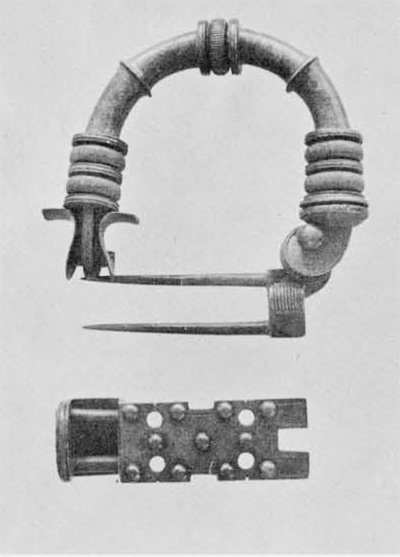
The shapes of the handled bronzes included large and small jugs with trefoil mouths for pouring, spouted jugs, the walls pierced at the points where the spouts were attached by small holes to serve as strainers; deep bowls with ring or bucket-handles; spouted bowls and bowls with handles attached at the rim and rising above it; two ladles; and bowls with ring-handles suspended from holders in which they swivel upward or downward. Of these last there were sixteen– evidently a popular form. Other examples have been found in contemporary Phrygian tombs at Ankara and still others in Cyprus and on the west coast of Asia Minor; but as these last are all later in date than the Gordion and Ankara bowls we take it that the type originated in Phrygia, probably at Gordion, and spread from there. Three of the ring-handled bowls from our tomb are of special interest and importance because they bear on the outer faces of their rims, close beside the handle, smears of beeswax, on the surface of which are scratched inscriptions. These are very brief and cannot for the present be read, though they are written with alphabetic letters. They are of great interest, however, as demonstrating that the Phrygians were not illiterate and had developed their own alphabetic writing on a Phoenician (and perhaps a Greek) model before the end of the eighth century.
A pair of bronze vessels in the form of situlae, or deep cups with bucket-handles across the open tops, are of the first importance. Their lower ends are in the form of animal heads– one a ram, the other a lion. The second was a teaser when it was found: members of the staff could remember having seen similar vessels, lion-headed situlae, but they could not remember where, or of what date, and of course we did not have at hand a library in which to look them up. All seemed to be agreed, however, that they did not have in mind an actual vessel but rather a portrayal of one in a relief or a picture. The parallels were found only when it was possible to consult the books: lion-headed situlae of exactly the same type and very close in style, shown carried by servants in the reliefs in the palace of Sargon II, King of Assyria, at Khorsabad. Sargon was a contemporary of Phrygian Midas, and had defeated him in battle.
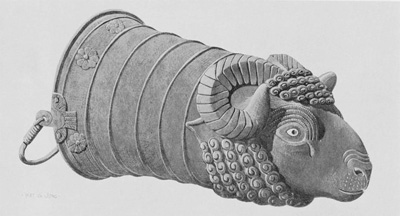
Image Number: 68113
He reigned from 722 to 705 B.C., and his palace reliefs are to be dated within those limits. The lion-headed situla this seems to have been in fashion in the last quarter of the eighth century, and the Khorsabad parallel suggests a date for our situla which in turn suggests a date for the making of the Gordion tomb. As in the case of the siren cauldrons we can for the present only speculate as to the source of the animal-headed situlae– whether Assyrian, Urartian, or Phrygian; but we cannot go far wrong in dating our tomb about 725-700 B.C., and the dating is confirmed as well as can be by the radiocarbon tests and by the bronze fibulae which also begin to appear on oriental reliefs at about this time.
Our tomb, then, demonstrates that by the end of the eighth century the Phrygians had attained to unexpected heights of skill as architects and engineers; that they were past-masters at cabinet making, inlaying, and small woodworking; that they had a bronze-working industry which could compete with the workshops of Assyria and Urartu. They had wide connections toward the east and south, importing flax of linen thread, perhaps cotton, glass, bronzes, and vessels of faience and pottery.
These objects attest wide connections and developed culture, but the cannot speak for themselves. Let us hope that future work in the city will give us some of the contemporary archives to fill in details of the picture of a people hitherto all but unknown, now shown to have been among the leaders of the civilization of their time.
